I had a student ask me:
“Is there anything you can recommend to help my hand strength, sometimes my hands cannot make the chord shapes that are required for a nice smooth clean chord, and I know one major problem that I have trouble with and hopefully you can help is chord switching in time, when I switch chords it takes me a while to get it to the right chord shape in time. Thanks.”
Being able to switch between chords smoothly is a common hurdle for beginner guitar players, but with the right techniques, you’ll soon be mastering those transitions. In this lesson, we’ll uncover 6 ways to improve switching between chords.
Here is a brief overview of what we’ll be covering:
- Press and release exercise
- Using common notes between chords
- Limit switching between two chords
- Visualize your next chord
- Remove unnecessary movements
- Practice using a metronome
We’ll go through each of these tips in more detail. Let’s get started!
1. Press and release exercise
Here is a simple exercise to develop playing a chord much quicker: Play the chord you want to get faster at, then release all your fingers for a moment. Repeat this over and over until you can press down the chord without having to think much about it.
This exercise helps you build muscle memory in your fingers so that whenever you need to play a specific chord, your fingers already know how it should feel. While you’re not switching between two chords in this exercise, it’s essential to be able to play one particular chord solidly first.
You also build strength in your fingers as you do this exercise. Although it may feel like you need to put a lot of pressure to press down a chord at first, later on, your hands and fingers naturally get used to the movement and it shouldn’t feel overbearing.
Learning chords on guitar can be similar to doing physical exercise. At first, your fingers might feel clumsy and tired, just like sore muscles after a new exercise. But with consistent practice, your fingers will build strength and memory, which makes it easier to switch chords smoothly.
Start with easier chords, and then try the same thing with chords that are more challenging for you. When you start switching between different chords, the time it takes to change will be shorter and shorter as you get better.
You can try this exercise with the basic chords on guitar. Check these out if you don’t know them already.
2. Using common notes between chords
This next tip is quite helpful and often overlooked when learning to switch between chords. The idea here is to think about all the common notes between chords so that you don’t have to lift off all your fingers as you switch to the next chord. When possible, doing this cuts down the time it takes to make a transition.
Examples of using common notes between chords
To give you some examples, look at the chords below to see what notes they share (common notes are highlighted in green).
The C Major and A minor chords share two notes in common which are the 1st and 2nd finger on your fretting hand. All you need to do to make the transition is to add or remove your 3rd finger on the fretting hand.
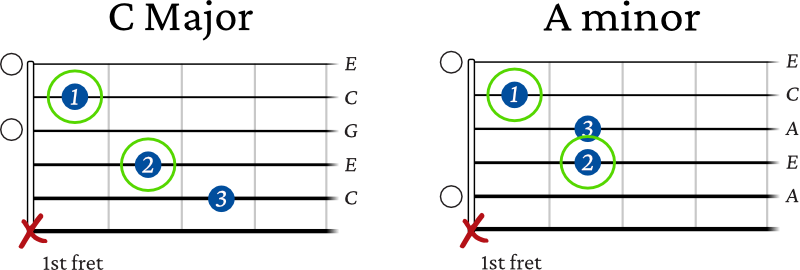
Another example is between a G Major and a D Major Chord. They both share the note on the 3rd finger for each chord shape.

The E minor and G Major chord share the 1st finger on both chord shapes.
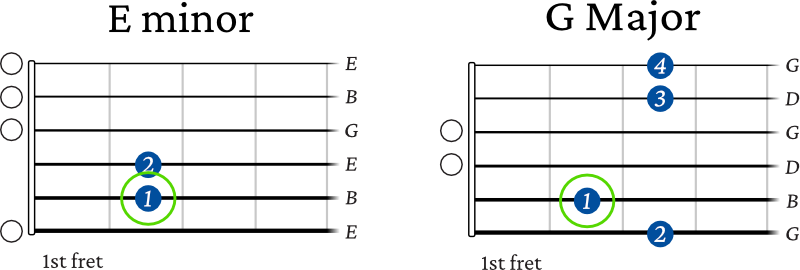
The F Major and C Major chord also share the 1st finger on both shapes.
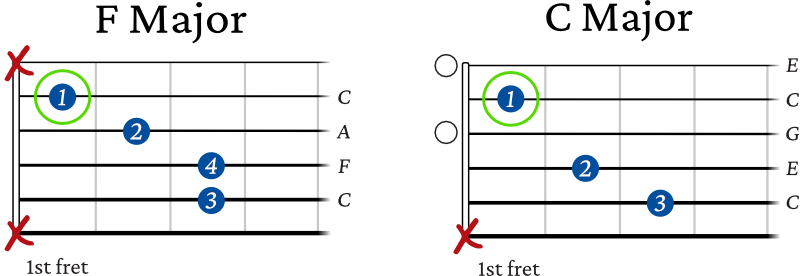
You won’t always have common notes when switching between chords, but look out for them and use them whenever possible.
3. Limit switching between two chords
If you are trying to learn a chord progression (a series of chords) in a song, first limit switching between two chords until that gets easier. Then you can try a different set of two chords and repeat those until that feels easier.
It may sound obvious but start with easier chords and then move on to harder ones. At this point, don’t worry about strumming patterns until you learn to place your fingers properly for the chords you’re learning.
With some practice, you’ll soon find yourself expanding to comfortably transition between 3 chords or more. For example, check out these easy chord progressions.
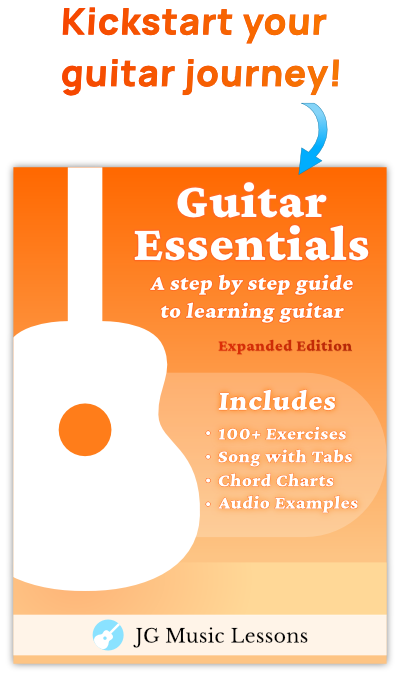
4. Visualize your next chord
By visualizing where you need to switch to, you get a head start on where each finger needs to move. Think about what the next shape looks like so that you can mentally and physically prepare for a smoother transition.
Over time, you won’t have to think about finger placement as much because you will develop muscle memory for the chords you’ve practiced.
Visualization of your next move is particularly useful when you don’t have any common notes between chords. There’s no ‘shortcut’ in these cases so you need to be aware of the upcoming changes.
5. Remove unnecessary movements
A lot of times we can unconsciously make unnecessary movements that can make transitions more difficult. For example, we may be overly lifting off certain fingers after a chord or pressing down too hard when it may not even be needed.
Press down on a note to see how much pressure you actually need to make it sound clear rather than using more energy than needed.
Another thing to watch out for is overly tightening up your hands which creates unnecessary strain.
Take a closer look at what your fingers are doing and think about how you can make the movements more efficient. Keeping this in mind will help you develop a good technique on your instrument which will benefit you in the long run.
6. Practice with a metronome
Once you get a good hang of the chords you’re learning, try using a metronome to test if you are keeping good timing consistently. Here is a free metronome on our site.
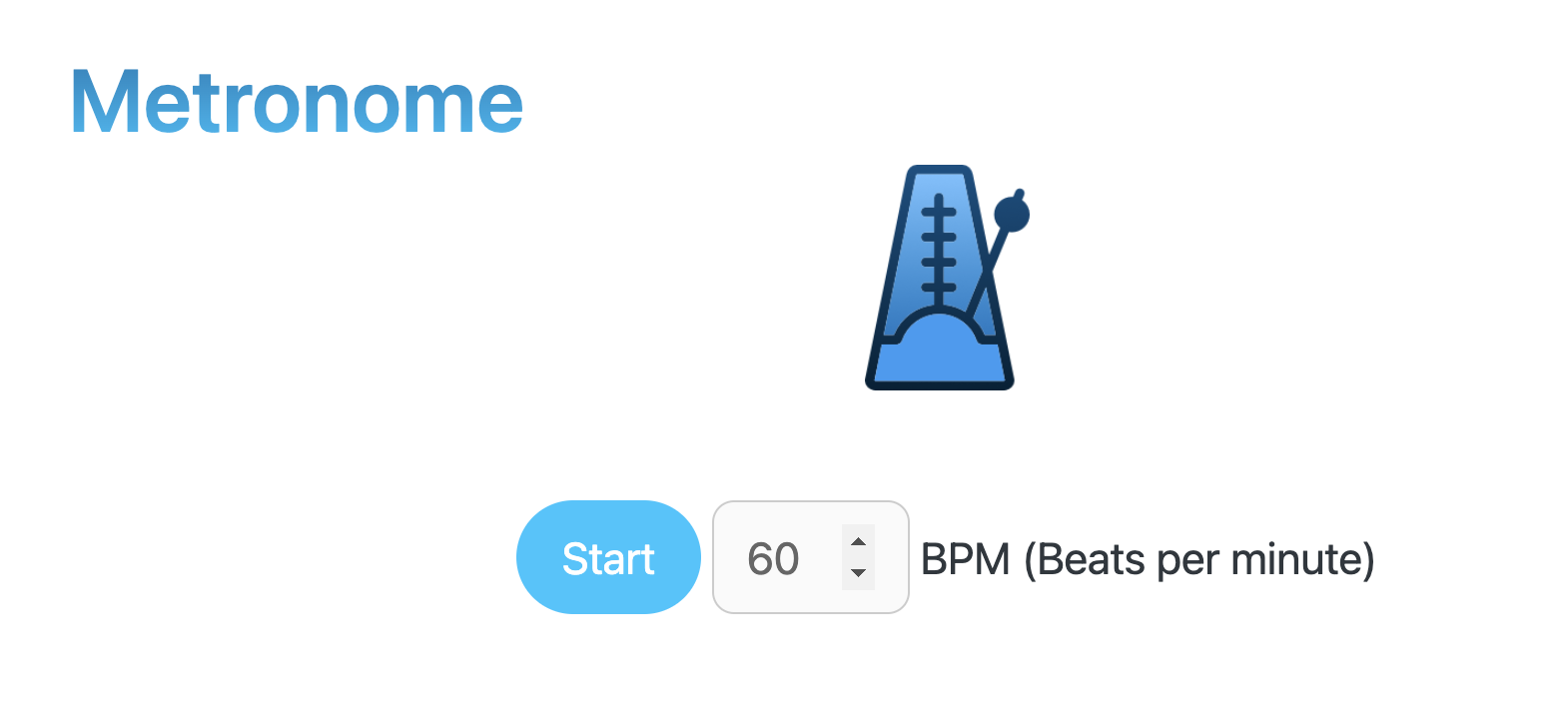
Make sure to start with a slow tempo and try to switch the chord every 4 beats. As you improve, you can gradually increase the tempo.
At this point, you can start to think about learning different strumming patterns that focus more on your opposite hand. If needed, here are 7 ways to get better at strumming on guitar.
Keep at it and you’ll soon be playing songs on guitar without getting stuck on the chords!
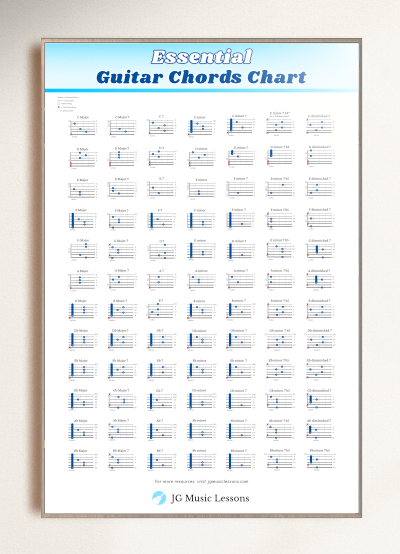
Wrapping up
If switching between chords is still a new skill for you, remember to take breaks while practicing to avoid overstraining your hands. Aim for having a consistent but also healthy pace so you can keep playing for a long time!
Although switching smoothly between chords takes time and repetition, I believe you’ll start to see great results by keeping these tips in mind!
You may also be interested in learning how to effectively memorize guitar chords.
📘 Get the free guitar practice guide here!
All the best,
JG Music Lessons
📙 Kickstart your guitar playing with our step by step guide: Guitar Essentials.
🎸 Looking for a travel or half-sized guitar? See this one.
🛠 See our other music recommendations.
🤝 Support the site to help us to create better content for you!
Level up with the FREE guitar practice guide and effectively improve your playing! 🎸
Get it sent to your email!



